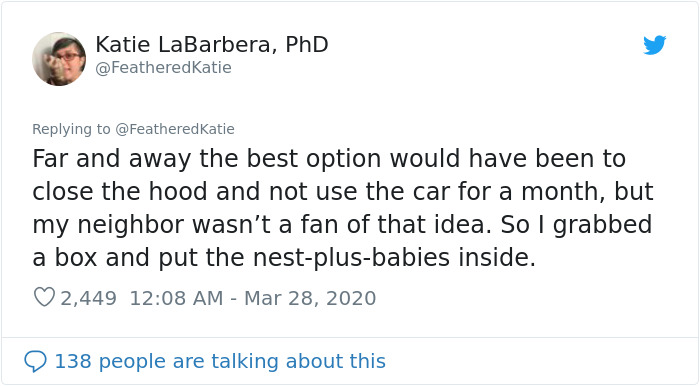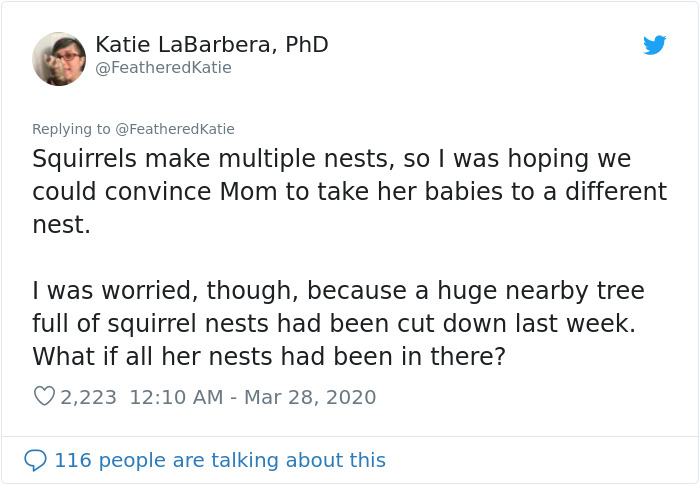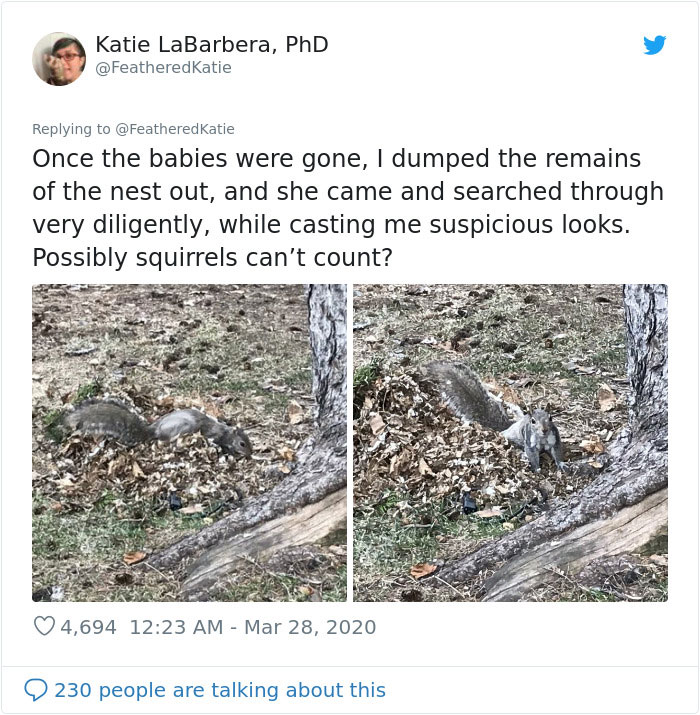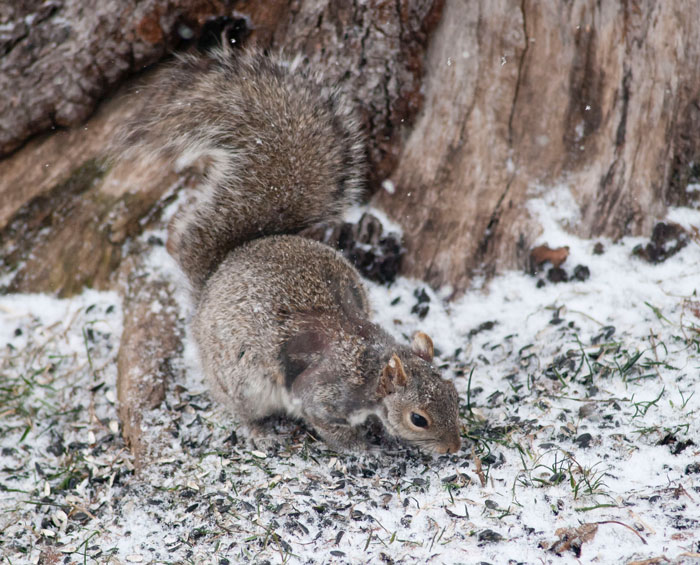
Neighbor Says Their Car Won’t Start, Woman Finds A Squirrel She Tried To Fatten Up Has Had Babies Inside The Car
Recently, Dr. Katie LaBarbera, who is a behavioral ecologist and ornithologist with a Ph.D. in Integrative Biology, Katie LaBarbera, overheard her neighbors talking outside. They were trying to figure out why their car wouldn’t start. When they popped the hood in search of the problem, LaBarbera’s neighbors discovered a squirrel nesting in the engine bay.
The biologist immediately went outside to offer some help. Tuns out, she was already familiar with the little critter! Everything soon turned into a rescue operation and LaBarbera did an excellent job of both relocating the family to the wild and documenting it all on Twitter. Soon, her story went viral and people were incredibly glad it had such a happy ending.
More info: Twitter
Image credits: FeatheredKatie
Image credits: FeatheredKatie
Don’t let the first impression fool you. Even though squirrels build their nests with whatever they can find, the actual construction is more complex than it might appear. Squirrels usually begin the process by weaving together a base of twigs to form a “basket” that holds the foundation of the nest. Then, they collect soft, compressible materials like wet leaves or moss. Next, squirrels will weave a second, outer net of twigs around this material to keep it compressed and will fill in gaps with more leaves or soft material.
In order to follow this blueprint, squirrels require rigid, soft, sturdy, and pliable materials. They will collect twigs, branches, leaves, moss, paper, garbage, vines, and pretty much anything else they can use. Squirrels are constantly on the lookout for these valuable building materials just like they never stop searching for food.
Image credits: FeatheredKatie
Image credits: FeatheredKatie
LaBarbera first noticed the squirrel because she looked scrawny and had big patches of fur missing, making her easily identifiable. “She often hung out by the tree outside my apartment window, and under a car parked right next to the tree, which in retrospect makes sense,” the biologist told Bored Panda. “I had begun leaving sunflower seeds out for her because she seemed like she could use the food.”
Image credits: FeatheredKatie
Image credits: FeatheredKatie
Image credits: FeatheredKatie
Image credits: FeatheredKatie
I had noticed while moving the nest that the babies could be inspired by motion to make noise. I tried picking up a baby (normally I’d do this with gloves, but who has gloves now??) and it helpfully squeaked, and then suddenly – Mom was there! pic.twitter.com/28w4lbzRvc
— Katie LaBarbera, PhD (@FeatheredKatie) March 28, 2020
Image credits: FeatheredKatie
Image credits: FeatheredKatie
Chances are, the mom already had somewhere to take her babies. Since squirrels are constantly on the move, going from bird feeder to bird feeder and even from yard to yard, it’s common for them to have second and third nests located near their main home at varying distances. Squirrels use these additional nests in an emergency situation, for example, when they need to hide from a predator, store extra food, or simply when they get exhausted and want to have a little rest.
Image credits: FeatheredKatie
Image credits: FeatheredKatie
Now that everyone’s safe, LaBarbera has a few takeaways to share. “Check under your car hood if you leave it parked somewhere for a week, or see a squirrel hanging out near it!” she said.
The woman highlighted that she has also heard a lot of stories of people finding kittens under car hoods, so it’s not just the squirrels we should look out for.
“If you find a baby animal, look up a wildlife rehabilitation hospital’s website for a number to call to ask for advice before you interfere,” LaBarbera advised. “Often what’s needed is just to give the parents time to take care of the situation themselves, as the squirrel did here. And, this event reminded me of how awesome animal moms can be: the squirrel mom was very brave, and in the video when I put the baby on the ground and she finds him, you can hear her make a little squirrel purr!”
LaBarbera took a few more photos of the momma squirrel
Image credits: FeatheredKatie
Image credits: FeatheredKatie
Image credits: FeatheredKatie
Image credits: FeatheredKatie
Even after the rescue, LaBarbera has been running into the squirrel mom. “[I] kept feeding the squirrel for several weeks, through two periods of snow (Minnesota spring!); eventually my neighbors complained about me attracting all the neighborhood squirrels, so I stopped.”
However, she managed to periodically photograph the critter throughout that time and noticed the results of all the care she’s given her. “Lately, it’s gotten hard to tell if I’m seeing her because her fur has grown back so much that she’s hard to distinguish. I do know where her new nest is, and I’m eagerly keeping an eye out, hoping to see the babies when they emerge.”
And chatted with her followers
Image credits: hejma002
Image credits: FeatheredKatie
Image credits: glowypanda
Image credits: FeatheredKatie
Image credits: authorharpmill
One Twitter user pointed out that LaBarbera could have avoided handling the babies if she had looked up baby squirrel cries on YouTube and just played those to attract the mother. “This would have been better,” the rescuer said. “I recommend people do that if they encounter this situation! Also, some general advice if you like your local urban wildlife: keep cats indoors; don’t use glue/sticky traps or rat poison; if you want to feed them, look up what foods are nutritious for them – bread isn’t good because it doesn’t have much protein or fat.”
Image credits: IBKinTN
Image credits: FeatheredKatie
Image credits: kewhite
Image credits: iflydca
70Kviews
Share on FacebookThank you very much Dr. LaBarbera. We have red squirrels and, fortunately, several acres. I have taken to planting more pecan trees [outside the fence] fruit trees and blackberry vines. I was able to have my property designated an "urban wildlife refuge" in Texas. We have possums, herons, ducks, mallards, geese, skunks, coyotes, raccoons, rabbits, owls, snakes, lizards, a myriad of wonderful wildlife. And no I use NO poisons on my property, just "natural predators" and the possums are fabulous for tick control.
Thank you for being caring and taking the time to rescue this little creature and her kits... many people only see squirrels as vermin. I disagree: "All creatures great and small, etc...". :)
How sweet! Leave pistachios and peanuts in the shell in her tree for a bit. They need to open shells on their own so their front teeth don't grow too long. And PECANS.We put black bird seed and peanuts and grapes out on a stool in the backyard so we can watch them out the window.
Thank you very much Dr. LaBarbera. We have red squirrels and, fortunately, several acres. I have taken to planting more pecan trees [outside the fence] fruit trees and blackberry vines. I was able to have my property designated an "urban wildlife refuge" in Texas. We have possums, herons, ducks, mallards, geese, skunks, coyotes, raccoons, rabbits, owls, snakes, lizards, a myriad of wonderful wildlife. And no I use NO poisons on my property, just "natural predators" and the possums are fabulous for tick control.
Thank you for being caring and taking the time to rescue this little creature and her kits... many people only see squirrels as vermin. I disagree: "All creatures great and small, etc...". :)
How sweet! Leave pistachios and peanuts in the shell in her tree for a bit. They need to open shells on their own so their front teeth don't grow too long. And PECANS.We put black bird seed and peanuts and grapes out on a stool in the backyard so we can watch them out the window.

 Dark Mode
Dark Mode 

 No fees, cancel anytime
No fees, cancel anytime 











































































203
13